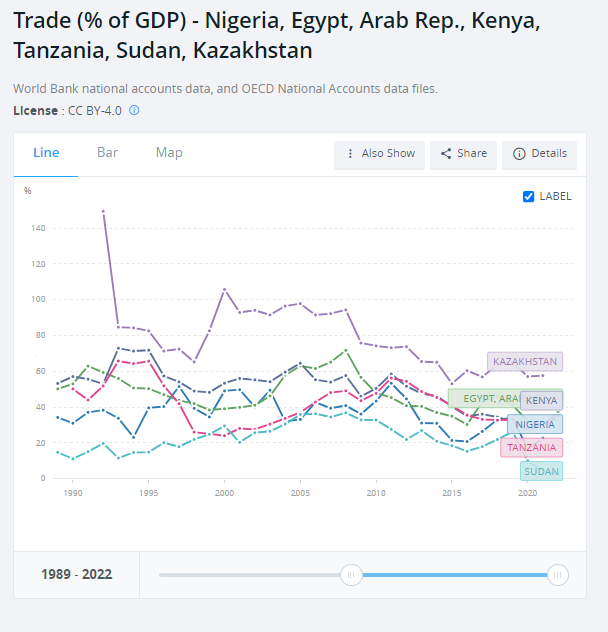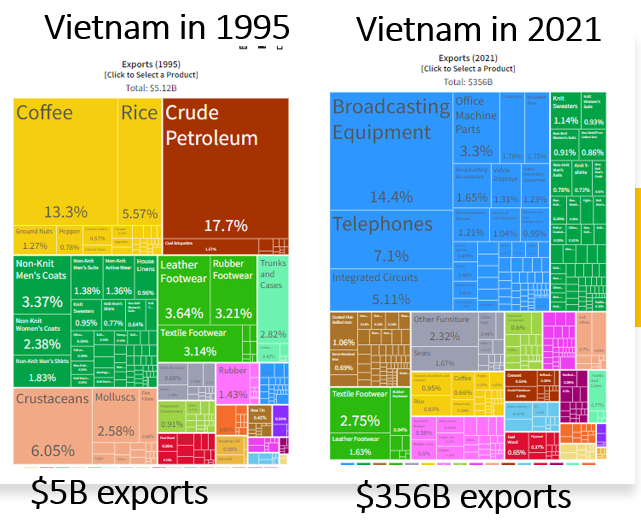How Many Nations Embraced Globalized Trade?
Would you be surprised if I told you that nations that call themselves Communist have embraced open trade more than capitalist nations have?
In America, there is a prevalent narrative that emphasizes the transformative influence of globalized trade on the American economy. From both Bernie Sanders and Donald Trump, you heard that free trade destroyed American jobs due to America’s “un-fettered, ideological commitment to global trade”. But is that really true?
In 1970, trade, which is measured in terms of importing and exporting goods from the rest of the world, was 11% of America’s GDP. When the Soviet Union was crumbling between 1989-1991, kickstarting the “era of globalization”, America nearly doubled its trade proportion from the 11% in the 1970s to 20%. After years of growth and decline since the cold war ended in the early 90s, America is still basically at the same trade proportion, trade is still 20% of GDP as 2022. See the graph below:

Out of all countries on earth, America ranks as the 4th least trade-dependent economy by percentage of global economic trade. This is because America has an enormous domestic market, so most companies and their workers focus mainly on the American market. In addition, 78% of the American economy is in services, which is slower to cross-border trade than selling iPhones, toys, or airplanes.
Interestingly, America's trade proportion aligns with that of countries such as Nigeria, Ethiopia, and Argentina. The irony lies in the fact that despite this relatively modest trade ratio, the United States boasts a staggering $25.5 trillion economy. In effect, while trade constitutes a fifth of America's economic output, America’s economic magnitude equates to almost a tenth of global trade itself!

To put more numbers on this, as of 2022, America’s economy is $25.46 Trillion. America imports from the world is $3.2 Trillion and exports $2.1 Trillion from the world in 2022. This means that American global trade (imports + exports) is $5.3 Trillion dollars. $5.3 Trillion out of America’s $25.46 Trillion means trade is 21% of American GDP as of 2022.
Interestingly, this $5.3 Trillion dollars of trade still makes America the 3rd world’s largest trading partner, losing only to China ($6.82 Trillion) at 2nd place and the European Union ($17.47 Trillion) at third place.
Since the dissolution of the Soviet Union in the years 1989-1991, the prevalent narrative suggested that capitalism had triumphed over Marxist-Leninist ideologies and global interconnectedness through trade had become the norm. However, only the former half of this narrative holds true. While capitalism has indeed gained traction, the notion that all countries universally became more interlinked within the global economy since the early 1990s is not entirely accurate. In this context, the United States serves as a notable example, maintaining its trade proportion in 2022 at a level comparable to that of the early 1990s.
Most countries that have followed America’s foot steps of maintaining levels of globalized trade or have somewhat boosted/decreased trade. Examples include:
Africa: Burundi, Tunisia, Algeria, Libya, Benin, Botswana, Cabo Verde, Cameroon, Central African Republic, Ivory Coast, Gabon, Ghana, & Namibia
East Asia & Pacific: Indonesia, New Zealand, Singapore & Malaysia (which are exceptionally globalized)
South Asia: Pakistan
Former USSR: Tajikistan, Armenia, Azerbaijan, Russia,
Middle East: Iran
Latin America: Belize
According to World Bank data, there’s only a handful of countries where international trade has genuinely transformed their economies. In fact, some countries have even de-globalized.
Countries that have De-Globalized since the end of the Cold War
Instead of embracing further globalized trade following the end of the Cold War, certain countries chose a path of de-globalization. Some of these nations include Nigeria, Egypt, Kenya, Sudan, Tanzania, and Kazakhstan.
Countries that have substantially increased their trade proportion (20% to 50% boost)
These nations somewhat embraced more trade, but didn’t fundamentally transform their economies because of trade:
East Asia & Pacific: Australia
South Asia: Nepal, Bhutan,
Former USSR: Uzbekistan, Belarus, Ukraine,
Europe: United Kingdom,
Latin America: Chile & Colombia
Countries that have doubled their trade Output as a percentage of their Economy
China's transformation is evident in its trade statistics. In 1989, trade was 19% of China’s GDP, as of 2022, trade is 38%! China has fundamentally transformed its economy to double its trade from the globe. Now China is the world’s largest trading nation at $6.82 Trillion. If we consider the European Union, which is the world’s largest trading bloc, then China comes in 2nd. Impressively, China alone is responsible for 12% of global trade, even more than the United States.
Another example of an entity that has nearly doubled its trade is the European Union(EU), particularly exemplified by countries such as Germany, Romania, Poland, Italy, Spain, Latvia, and Greece. The EU is the largest trading entity on earth, trading, 105% of its economic output or $17.47 Trillion dollars. This makes the European Union responsible for 30% of global trade.
Other examples of nations/entities that have doubled or nearly their trade relative to their economy besides the European Union and China include:
South Asia, East Asia, & Pacific: Japan, South Korea, Thailand, The Philippines, The Island of Taiwan, Mongolia, Bangladesh,
Middle East & North Africa: Turkiye, ,
Latin America: Brazil, Peru, & Mexico
Africa: Chad, Democratic Republic of Congo, Mozambique, Senegal, & Morocco
Note that not every nation on this list of nations that have doubled their trade are fast growing economic stars.
Several African nations, for example, have shown growth through trade, but due to starting from a smaller base, they are still striving for "catch-up" growth.. In addition, Congo, Mozambique, and Chad are mainly commodity exporters, which are notoriously volatile in price. To truly thrive in globalization, a nation needs to integrate into complex global supply chains, following the models of East Asia and the European Union. Morocco and Turkey have become integrated with car and aerospace manufacturing in Europe. Mexico is integrated with the North American supply chain.
Countries that have TRIPLED or almost Tripled their trade Output as a percentage of their Economy
Once a French colony, impoverished Vietnam embraced communism and endured Japanese occupation during WW2, France reclamation attempts, a massive 7.5M ton U.S. bombing campaign, and a subsequent Chinese invasion after American withdrawal. Vietnam, like China was, tired of starving, so they embraced market reforms which Vietnam calls “Doi Moi”. By 1995, Vietnam transformed from selling $5 Billion worth of food, clothes and crude oil, to becoming a major machine, phone, computer, textile, electric battery and semiconductor exporter by 2021!
Vietnam’s proximity to electronics powerhouses like China, South Korea, Singapore, Taiwan, and Japan makes it an attractive destination for development. Vietnam has been known to be an alternative investment destination to China, also known as “Alt-Asia”.
Other nations that have tripled their trade proportion include Cambodia, India, and Rwanda.
In short, the post-Soviet Union, globalization era saw varying degrees of free trade adoption among nations. Surprisingly, nominally communist nations like China, Cambodia, and Vietnam have embraced free trade more vigorously than capitalist nations like America, which has maintained its trade proportion since 1989. The greatest successes emerged from nations that fully embraced trade, integrated themselves in complex supply chains, and manufactured sophisticated goods like semiconductors, cars, and smartphones. The biggest winners of post-Cold War trade are primarily located in East Asia (Japan, South Korea, Vietnam, China, Cambodia, and Taiwan), along with the European Union, Bangladesh, and India.
Will these nations be even more free trading thirty years from now or will we see a retrenchment in global trade? Will America invest more in Alt-Asia? We’ll have to wait and see.
Note:
If you are asking “How can an economy trade more than its GDP?”
The answer is trade isn’t a component in GDP but rather, net exports is.
The Formula for GDP is:
Business Investment + Government Spending + Domestic Consumption + Exports - Imports.
In this formula net exports (exports - imports) reflect the trade surplus or trade deficit that contributes to GDP
The Formula for trade is: Exports + imports. This just shows the total value of goods and services moving across borders.
Links are attached!
Also, I used “The Globalization Myth: Why Regions Matter” as inspiration.










Very interesting article. One additional point is that people often conflate “free trade” (by that I mean low levels of tariffs) with the percentage of national trade that is imports and exports. A nation can have low tariffs with relatively low levels of exports and imports. The US being the biggest example.